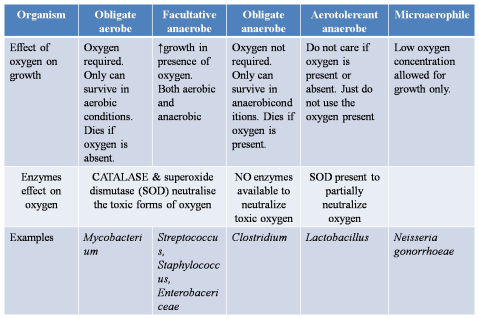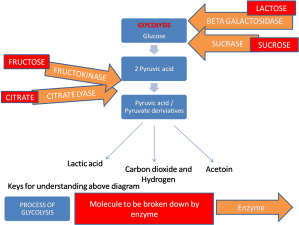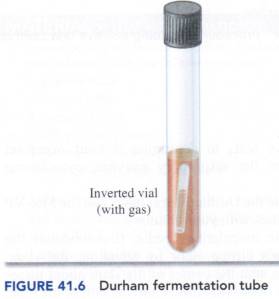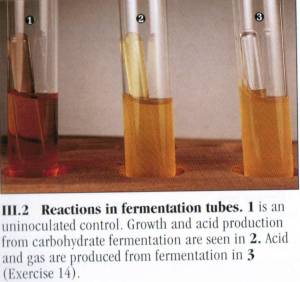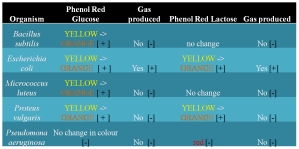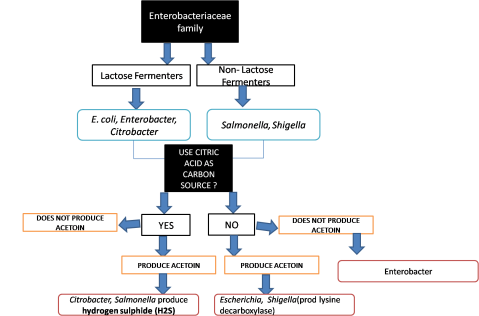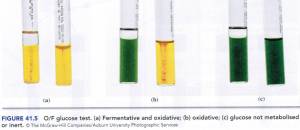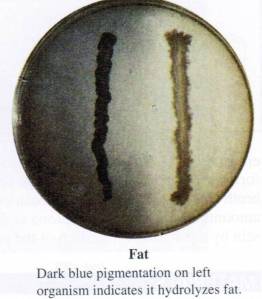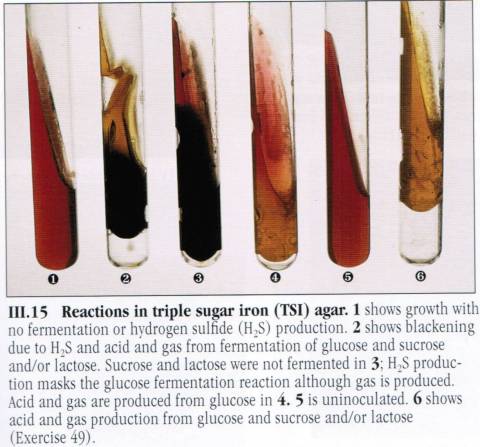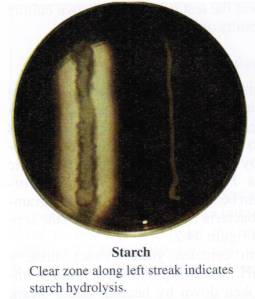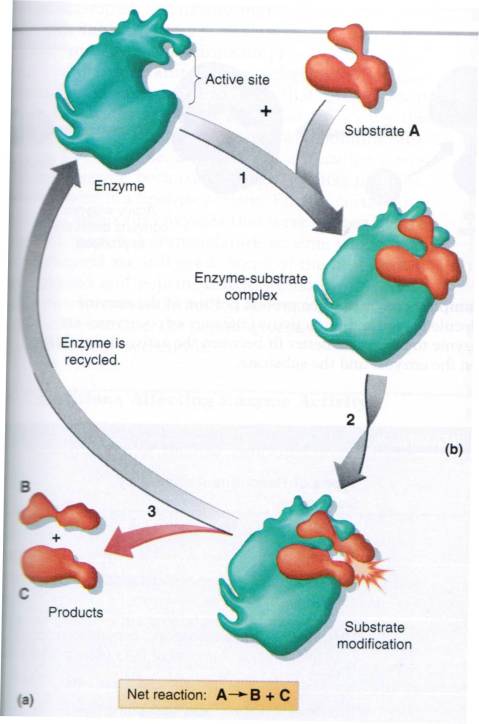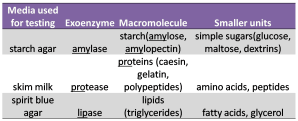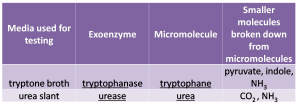Catalase test
Posted on: July 30, 2009
Oxygen is sometimes toxic.
Small amounts of superoxide free radicals are formed during the normal respiration of organisms that use oxygen as the final electron acceptor.
Obligate anaerobes from some oxygen free radicals that are toxic to the cell. Hence, if bacteria wants to grow in oxygen environment, enzymes like catalase and superoxidase dismutase must be present for neutralization of the toxic form of oxygen(oxygen radical)
During normal aerobic respiration, hydrogen ions are produced and have to be removed by bacterial cell. The electron transport system (ETS) in cellular respiration (a part of glycolysis) involves these H+ ions and combines them with oxygen to form water. Water is harmless. Energy is given off and stored in the form of Adenosine Triphosphate.
What is toxic is Hydrogen Peroxide that is formed by the cytochromes in ETS. Water being harmless is not required to be removed by the bacteria. So, what is harmful to bacteria cell that requires it to be removed instantly??
answer: H2O2.
Functions of catalase
Protects bacteria from toxic hydrogen peroxide (H2O2) accumulation, which can occur during aerobic metabolism. If hydrogen peroxide accumulates, it becomes toxic to the organism.
Since Catalase breaks H2O2 down into water and O2, the presence of oxygen can be characterized by bubbles which indicates a (+) result.
What bacteria could mostly likely be detected?
most aerobic organism make catalase. 
http://student.ccbcmd.edu/courses/bio141/labmanua/lab8/catstaph.html
Most aerobic organsims will display (+) results.
e.g. Staphyloccocus aureus.
Some anaerobic organisms will display (-) results, indicating that they do not produce catalase to prevent oxygen accumulation. Why?
Because since oxygen is totally not used for survival of these organisms, they do not have the ability to produce catalase.
e.g. Clostridium, Lactobacillus, Streptococcus
Carbohydrate Oxidation-Fermentation
Posted on: July 28, 2009
Fermentation can occur in the presence of oxygen or absence of oxygen.
If bacteria utilises carbohydrates for nutrients, there may be 2 end products, a gas and acid. The substrate formed from the metabolism of carbohydrate is either glucose or lactose.
Even if bacteria releases enzymes that enable to use carbohydrates through fermentation and oxidation, gas may or may not be produced.
FERMENTATION is noted by acid production which can be observed by a colour change in Durham tubes aka carbohydrate fermentation tube.
Phenol Red indicator is red in neutral or alkaline solution
If acid is present(+), phenol red changes from red –> yellow
If there is a small “space” at the top of the small tube, it means that gas is trapped in the small inverted tube inside the bigger tube. Therefore, gas is produced from the breakdown of carbohydrates.
Alfred.E.Brown. (2007). Bensons’s microbiological applications: laboratory manual in general microbiology. (10th ed.). New York: Mc Graw Hill.
Johnson, T.R., & Case, C.L. (2007). Laboratory experiments in microbiology. (8th ed.). San Francisco: Pearson Education.
Look at the 1st picture above, why is it red if gas is produced and it just means fermentation has occured?
Due to prolonged incubation periods(more than 24h), bacteria will begin to grow oxidatively(oxygen dependent) on the peptone contents of the fermentation medium after using up the carbohydrate contents, causing the neutralization of phenol red indicator and turing it red due to NH3 production.
The only organism that has the ability to break down carbohydrate into glucose and lactose is E.coli and it also has the ability to produce gas during fermentation.
For P. aerguinosa, it displayed negative results for all, which means it can’t break down carbohydrate into glucose & lactose.
Another test which is the MRVP test is able to differentiate between organisms that produce large amounts of acid and organisms that only produce neutral content(acetoin)
M-Methyl Red. VP- Voges -Proskauer. Methyl Red is different from Phenol Red that we mention earlier. It has a pH of 4.4-6. Hence, it changes colour at this range.
For MR test, if organic acid is produced here, the (+) result is just a no change in colour of Methyl Red. RED remains.
if neutral acetoin is produced here, the (-) result is a change in colour from RED to YELLOW because at pH 7, the indicator will change its colour.
Johnson, T.R., & Case, C.L. (2007). Laboratory experiments in microbiology. (8th ed.). San Francisco: Pearson Education.
To test for the presence of acetoin, we use VP test where potassium hydroxide and α naphthol are added.
The upper of the medium will turn red. (+) If the medium turns light brown, it is a (-) result.
Please note that production of acetoin is also affected by the duration of incubation, hence, false negative results may be observed.
We can use Koser’s citrate or Simmon’s citrate to test for the ability of bacteria to ferment citrate. When citric acid or sodium citrate is in solution, it loses a proton or sodium ion to form a citrate ion. Bacteria with citrate lyase can break down citrate to form pyruvate. Pyruvate can be further reduced in fermentation.
Purpose of performing the citrate test
- Tests for the ability of bacteria to convert citrate (an intermediate of the Kreb’s cycle) into oxaloacetate (another intermediate of the Kreb’s cycle)
Contents of Simmon citrate include
- sodium citrate as the carbon source
- monoammonium phosphate as the nitrogen source
- and bromthymol blue indicator that changes to blue when medium turns alkaline, which means (+) result.
Why alkaline means citrate is utilised by the bacteria?
When bacteria uses citrate(carbon) and ammonium(nitrogen), medium turns alkaline as ammonia is produced from ammonium.
Johnson, T.R., & Case, C.L. (2007). Laboratory experiments in microbiology. (8th ed.). San Francisco: Pearson Education.
Citrobacter, Enterobacter will display (+) result while E. coli & Klebsiella will display (–) result.
After knowing that some bacteria utilises citrate, we can also find out if other products are formed during metabolism. For example, Hydrogen Sulphide.

Johnson, T.R., & Case, C.L. (2007). Laboratory experiments in microbiology. (8th ed.). San Francisco: Pearson Education.
Oxidative-Fermentative Metabolism
Posted on: July 27, 2009
How do we determine if type of metabolism is fermentative or oxidative?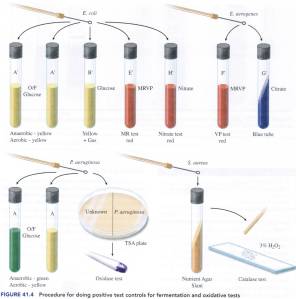
we will test with an glucose OF oxidative- fermentative agar. If agar turns yellow, acid is produced. If agar turns green, no acid is produced. Motility of the bacteria can also be determined by the presence of turbidity (cloudiness)
OXIDATIVE metabolism may or may not cause an acid to be produced for aerobic conditions. No acid will be produced for anaerobic conditions.
FERMENTATIVE metabolism will cause an acid to be produced for aerboic and anaerobic conditions.
Alfred.E.Brown. (2007). Bensons’s microbiological applications: laboratory manual in general microbiology. (10th ed.). New York: Mc Graw Hill.
UREASE breaks down urea into ammonia (NH3) & carbon dioxide (CO2).
Alfred.E.Brown. (2007). Bensons’s microbiological applications: laboratory manual in general microbiology. (10th ed.). New York: Mc Graw Hill.
Properties of urea medium
Since there’s phenol red pH indicator, pH indicator changes from yellow to bright pink if NH3 is produced.
At more than pH 6.8, the colour change represents a (+) result
Proteus vulagris is one bacteria that produces urease to break down urea.
Tryptophan Degradation
Posted on: July 25, 2009
Tryptophan is degraded by tryptophanase into indole, ammonia, pyruvic acid. Pyruvic acid is then involved in metabolic pathway so that ATP energy for bacterial cell is generated. While other products like NH3 and Pyruvate is metabolised, indole is not. Hence, it stays in the medium.
Upon addition of Kovac’s reagent, deep red ring at the top of the agar/ broth is formed when Kovac’s reagent reacts with indole. This is the (+) result.
E.coli is one of the organism that can display (+) result since exoenzyme tryptophanase is produced.
Alfred.E.Brown. (2007). Bensons’s microbiological applications: laboratory manual in general microbiology. (10th ed.). New York: Mc Graw Hill.
Properties of Tryptic Soy Broth/Agar
-tryptone is one of the contents of TSB/ TSA and is derived from casein.(recall protein from protein hydrolysis)
Lipolysis
Posted on: July 25, 2009
Lipolysis is carried out by LIPASES.
Triglycerides(big molecules derived from lipids) are broken down into fatty acids & glycerol
If pH of medium, used for testing whether lipase is present to break down lipids, is lowered. It indicates acidic product (fatty acid) is formed.
Trigylceride used here is tributyrin that can be found in medium Spirit Blue Agar.
There are 2 indicators for (+) result.
- dark blue precipitate(tributyrin is completely broken down into fatty acids) OR
- oil droplets (when tributyrin is not completely broken down into fatty acids)
Organism responsible for exhibiting (+) result is Staphyloccocus aureus.
Alfred.E.Brown. (2007).Bensons’s microbiological applications: laboratory manual in general microbiology. (10th ed.). New York: Mc Graw Hill.
Properties of Spirit Blue Agar
Contents- tributyrin (simple animal triglyceride)
Tributyrin acts as a substrate for exoenzyme lipase.
Protein Catabolism (Proteolysis)
Posted on: July 25, 2009
Proteolysis is carried out by PROTEASE.
In the following posts we will mention
– bacteria’s ability to hydrolyse casein, gelatin
– urea hydrolysis by detecting presence of urease(refer to post on nitrogen metabolism- urea hydrolysis)
-hydrogen sulphide production
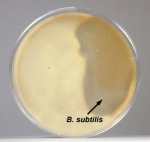

Casein(a protein) is broken down by protease into peptones and amino acids.
During the degradation process, polypeptide bonds are broken.
Once the bonds are broken, amino acids are produced. A clear zone surrounding streak line of agar indicates a (+) result.
Organism that gives (+) result is Bacillus subtilis, Clostridium spieces. (-) results are indicative that organismdoes not cause a clear zone. an example of organism displaying (-) result is Escherichia coli.
Alfred.E.Brown. (2007). Bensons’s microbiological applications: laboratory manual in general microbiology. (10th ed.). New York: Mc Graw Hill.
Properties of skim milk agar
- Skim milk agar contents- casein, lactose and other nutrients, which support growth of lactobacilli.
- Gives the white colour to milk.
As seen from the above, we can infer if bacteria present in milk is able to break down the casein in milk, milk may have abnormal particles that are not white in colour.
Application of this biochemical this is in food testing.
Another protein commonly found in food products is gelatin.
It is broken down by gelatinase into smaller polypeptides, peptones and amino acids that can cross the cell membrane and be utilised by the organism.
Property of Gelatin agar
INTERESTING to note: when gelatin is broken down via hydrolysis, it cannot solidify anymore, the areas of solid gelatin media where the organsim grows, will turn into liquid. Even if you refrigerate this medium, the media will remains liquid.
Johnson, T.R., & Case, C.L. (2007). Laboratory experiments in microbiology. (8th ed.). San Francisco: Pearson Education.
Hence, a (+) result is indicated by the liquid state of gelatin. Bacillus subtilis is able to produce proteolytic exoenzyme gelatinase to give the (+) result.
Why is gelatin not used widely as a selective media for isolating bacteria? (hint: what is gelatin agar unique property?)
Most bacteria do not contain enzymes that liquefy gelatin. Hence, it is not uselfy for isolating microbes for bacterial identification.
Decomposition of amino acid “cysteine” is detected by the formation of ferrous sulphide when Hydrogen Sulphide is release.
Why? Some bacteria have the ability to give off H2S from sulphur containing amino acids after proteins are broken down into amino acids by enzymes.
When H2S is produced, sulfide ion reacts with the metal salt to product a black precipitate(+) result.
Johnson, T.R., & Case, C.L. (2007). Laboratory experiments in microbiology. (8th ed.). San Francisco: Pearson Education.
LOOK AT TUBE 3. the black ppt indicates that Hydrogen Sulphide was produced. (+). Bacteria that produces (+) are Citrobacter, Salmonella.
Starch Hydrolysis
Posted on: July 25, 2009
Reaction carried out by AMYLASE is starch hydrolysis
Reagent required to be added
- Iodine (pH indicator)
Starch + iodine –> starch- iodine complex
Undegraded starch reacts with Iodine to form a dark blue starch- iodine complex that covers the entire agar. (-)
- Escherichia coli
If starch(polysaccharide) is broken down into glucose(or any other monosaccharides/ di saccharides), glucose will then react with iodine, forming a clear zone surrounding streak line. (+)
Organism that gives (+) results
- Bacillus substilis
Alfred.E.Brown. (2007). Bensons’s microbiological applications: laboratory manual in general microbiology. (10th ed.). New York: Mc Graw Hill.
Here are other photos of starch hydrolysis test where drops of bacteria culture were placed onto the agar medium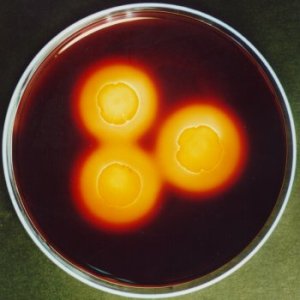
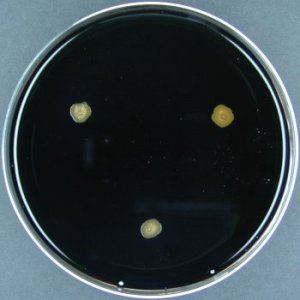
http://www.microbiologyatlas.kvl.dk/biologi/english/showbio.asp?articleid=plade2
Properties of starch agar are related to its contents like beef extract, soluble starch, and agar
Beef extract provides the nitrogen, vitamins, carbon and amino acids, while agar is the solidifying agent.
It is a differential medium used to determine whether a bacteria is able to use starch as a carbon source and an energy source.
Introduction to biochemical tests
Posted on: July 25, 2009
Purpose of Biochemical Tests
Makes use of enzymatic activities to differentiate among bacteria.
It does not mean if 1 bacteria in the same bacterial group can ferment carbohydrate, all others will.
Examples of biochemical reactions are oxidation, fermentation, hydrolysis and degradation.
*in later parts of the posts, u will come across terms like proteolysis, lipolysis. So what do they mean? lysis= breakdown.
Proteo = protein. Lipo = Lipid
Products of biochemical reactions cause changes to the medium that you have inoculated the organism with.
E.g. an acidic product↓pH of a medium.
Bacteria have a rigid cell wall. This cell wall causes the bacteria to be unable to surround and eat their food through phagocytosis. Bacteria uses metabolism to gain nutrients.
pH indicator in the medium will exhibit a color change indicating that an exoenzyme is released by a bacteria that cause the product to be formed.
How do bacteria obtain nutrients then?
- excretion of exoenzymes
exo= outside. exoenzymes- enzymes outside cell that break down large molecules
- macromolecules are broken down into smaller units
- smaller units can enter bacterial cell for metabolism
Properties of enzymes
Larry McKane., & Judy Kandel. (1996). Microbiology: essentials and applications. (2nd ed.). New York: McGraw Hill.
- Simple enzymes are composed entirely of proteins.
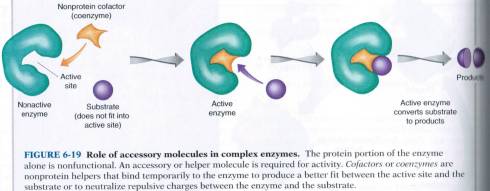
Larry McKane., & Judy Kandel. (1996). Microbiology: essentials and applications. (2nd ed.). New York: McGraw Hill.
- Complex enzymes contain additional non protein molecules tightly associated with the protein.
Tightly associated accessory molecules are referred to as prosthetic groups.
- Enzymes are highly specific in their catalytic action.
In general, an enzyme works like a jigsaw. It recognizes only 1 set of substrate. Substrate is the material on which enzyme acts. After enzyme acts, substrate is converted to one particular set of products.
Enzyme has an area known as the active site that reacts with the substrate. The substrate must fit nicely into the active site.
If shape does not fit into the jigsaw(enzyme), nothing happens.
- Some enzymes require small molecules to help carry out their catalytic role. Without these small helper molecules, such enzymes are inactive. There are other helper molecules that are “temporary” parts of enzyme. These temporary parts assist in enzyme- mediated reaction. They can be organic molecules(coenzymes) or metals that function as cofactors.
Coenzymes can be electron carriers NAD, NADP, FAD.
DO you know how to identify enzyme?
Enzyme usually ends with a “ase”
- Oxidase
- Urease
- Gelatinase
- Catalase
- Lipase
- Dehydrogenase
- Protease
Functions of enzymes
Marcromolecules are degraded.
Does it mean that small molecules will not be degraded?
NO! small molecules like tryptophane are degraded so that they can acquire carbon compounds to prepare for metabolism.
